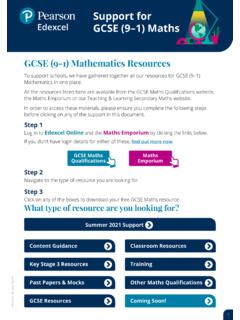Transcription of Computer Science Revision Notes GCSE IGCSE - Exam Papers …
1 These are Computer Science Revision Notes for IGCSE / gcse to be used for mocks. Theory Data representation Binary systems The circuits in a Computer 's processor are made up of billions of transistors. A transistor is a tiny switch that is activated by the electronic signals it receives. The digits 1 and 0 used in binary reflect the on and off states of a transistor. Hexadecimal Why use hex? Higher information density. (more information stored in fewer digits than binary. Used to simplify how binary is represented. Therefore, It is much easier to write numbers as hex than to write them as binary numbers. A hex digit can be any of the following 16 digits: 0 1 2 3 4 5 6 7 8 9 A B C D E F. It is important to note that computers do not use hexadecimal - it is used by humans to shorten binary to a more easily understandable form. Some examples of where hex is used include: MAC (media access control) addresses F1D07654-A63C-4D82-8883-94F957F22888.)
2 Error messages 0x8899FF. HTML colour references #FF6600. Data storage sound (music), pictures, video, text, and numbers are stored in different formats. There are many types of file types for storing data, these may include: Mp3 for sound, Mp4 for video, JPEG for images, MIDI (Musical Instrument Digital Interface). Compression is the method computers use to make files smaller by reducing the number of bits (1's and 0's) used to store the information. For more help please visit our website Compression can be lossy or lossless. Lossless compression means that as the file size is compressed, the picture quality remains the same - it does not get worse. Also, the file can be decompressed to its original quality. Lossy compression permanently removes data. For more help please visit our website Communication and Internet technologies Data transmission Data transmission refers to the process of transferring data between two or more digital devices.
3 Data is transmitted from one device to another in analog or digital format. In serial transmission, Data is organized in a specific order and is sent one bit at a time. Serial transmission is slow but reliable as data will always be in the correct order. (USBs use this). In parallel data transmission, multiple bits are transmitted over multiple channels at the same time. Data is sent faster but runs the risk of becoming skewed (disordered). ( Integrated Circuits use this). In half-duplex, data can be transmitted in both directions on a signal carrier except not at the same time. In a duplex, data can be transmitted both ways at the same time. In simplex data can only be transmitted one way. Data detection makes sure that the data we send to others is identical and unaltered when they receive it. Security aspects In section Internet principles of operation A web browser, or simply "browser," is an application used to access and view websites.
4 ISPs provide access to the Internet as well as other services including email, web hosting, and security services. HTML (hypertext markup language) is a markup language that tells a browser how to display a document in the form of a website that makes sense to the user. It allows the browser to identify document heading, lists, paragraphs, and so on. HTTP is a Hypertext transfer protocol. Simply put - Rules to sending, formatting, and receiving text-based messages. HyperText Transfer Protocol Secure (HTTPS) is the secure version of HTTP, the protocol over which data is sent between your browser and the website that you are connected to. It means all communications between your browser and the website are encrypted. The structure consists of the mandatory parts of an HTML document plus the semantic and structured markup of its contents. Presentation is the style you give the content (mainly how it looks).
5 MAC addresses are unique codes assigned by a manufacturer to a device. IP addresses are unique addresses that identify a device on the Internet or a local network. A uniform resource locator (URL) is the address (location) of a resource (websites) on the Internet. Cookies are small pieces of data sent from a website and stored on the user Computer by the users web browser. Disadvantages- privacy of users, sometimes not secure Advantages- more effective marketing, recalls information for logins, etc Hardware and software Logic gates Logic gates are the basic building blocks of any digital system. It is an electronic circuit having one or more than one input and only one output. The relationship between the input and the output is based on a certain logic. Based on this, logic gates are named as AND gate, OR gate, NOT gate, etc. For more help please visit our website AND Gate A circuit that performs an AND operation is shown in the figure.
6 It has n input (n >= 2). and one output. Logic diagram Truth Table OR Gate A circuit that performs an OR operation is shown in the figure. It has n input (n >= 2). and one output. For more help please visit our website Logic diagram Truth Table NOT Gate NOT gate is also known as Inverter. It has one input A and one output Y. Logic diagram For more help please visit our website Truth Table NAND Gate A NOT-AND operation is known as a NAND operation. It has n input (n >= 2) and one output. Logic diagram For more help please visit our website Truth Table NOR Gate A NOT-OR operation is known as a NOR operation. It has n input (n >= 2) and one output. Logic diagram For more help please visit our website Truth Table XOR Gate XOR or Ex-OR gate is a special type of gate. It can be used in the half adder, full adder and subtractor. The exclusive-OR gate is abbreviated as EX-OR gate or sometimes as X-OR gate.
7 It has n input (n >= 2) and one output. Logic diagram For more help please visit our website Truth Table XNOR Gate XNOR gate is a special type of gate. It can be used in the half adder, full adder and subtractor. The exclusive-NOR gate is abbreviated as EX-NOR gate or sometime as X-NOR gate. It has n input (n >= 2) and one output. Logic diagram For more help please visit our website Truth Table Computer architecture and the fetch-execute cycle Von Neumann architecture design consists of a Control unit , Arithmetic and Logic unit (ALU), Memory unit , Registers, and Inputs/Outputs. The Central Processing unit (CPU) is the electronic circuit responsible for executing the instructions of a Computer program. Arithmetic and Logic unit (ALU). The ALU allows arithmetic (add, subtract, etc) and logic (AND, OR, NOT, etc) operations to be carried out. Control unit (CU).
8 For more help please visit our website The control unit controls the operation of the Computer 's ALU, memory, and input/output devices, telling them how to respond to the program instructions it has just read and interpreted from the memory unit . Clock speed measures the amount of functions being carried out by the CPU. Registers Very fast small memory stores for data such as numbers Memory unit The memory unit consists of RAM, sometimes referred to as primary or main memory. Unlike a hard drive (secondary memory), this memory is fast and also directly accessible by the CPU. Buses Buses are the wires through which data is transmitted from one part of a Computer to another, connecting all major internal components to the CPU and memory. Address Bus Carries the addresses of data (but not the data) between the processor and memory Data Bus Carries the actual data between the processor, the memory unit and the input/output devices Control Bus Carries control signals/commands from the CPU (and status signals from other devices) in order to control and coordinate all the activities within the Computer .
9 Summary of the fetch-decode-execute cycle Fetch: The CPU fetches the next instruction from the RAM (or cache). Decode: The CPU decodes the instruction to found out what it is asking the CPU to do Execute: Using the ALU the CPU carries out the task specified by the instruction. The CPU may need to fetch more data from the main memory. Input devices Input devices are peripherals used to provide data and control signals to a Computer . Input devices allow us to enter raw data for processing. For more help please visit our website Microphones are input devices that take analogue sound waves and convert them into electrical signals, suitable for a Computer to understand. Digital cameras are input devices that capture images (and sometimes video) digitally. 2D scanners perform the task of turning a 2D document or image into a digital file. A 3D scanner is an input device that creates a 3D model of the object scanned.
10 Developed long before touchscreens became affordable, interactive whiteboards combine a large touch-sensitive board with a projection screen. A barcode is a machine-readable code represented by an image consisting of black and white lines. The lines in a barcode relate to numbers 0 to 9. Black and white surfaces reflect light differently, this is how the scanner is able to identify the corresponding digits from the lines. Scanning a barcode is easier and faster than typing in a series of numbers by hand. A QR code is a Computer -generated pattern capable of holding a modest amount of data. This data is accessed when the QR code is read by a QR scanner. We often see a smartphone used as the scanning device although this doesn't have to be the case.. A touchscreen is an electronic visual display that also incorporates an input device that responds to touch.





